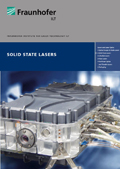When developing tailored laser oscillators, we draw on our experience with various active laser media. For this purpose, Nd-, Tm-, Ho-, Er- and Cr-doped crystals, among others, are used. Pump and resonator arrangements are optimized for crystals in slab, rod or disk geometry. Together with partners from research and industry, we also develop novel kinds of crystals in order to generate wavelengths adapted to an application in a direct and efficient manner.
We calculate and optimize efficiency, stability and beam quality of laser resonators by means of analytical and numerical analysis and simulation processes. When the resonator is Q-switched and the mode-coupled, laser pulses are generated whose duration, energy and repetition rate can be adapted within a wide range. The spectral bandwidth of laser pulses can be narrowed to the bandwidth limit by seeding the laser oscillator with a highly stable reference laser source. The laser frequency is stabilized by actively controlling the resonator length.
On this basis, we develop and build lasers for a wide range of applications, from materials processing to plasma generation all the way to the detection of trace gases.

 Fraunhofer Institute for Laser Technology ILT
Fraunhofer Institute for Laser Technology ILT